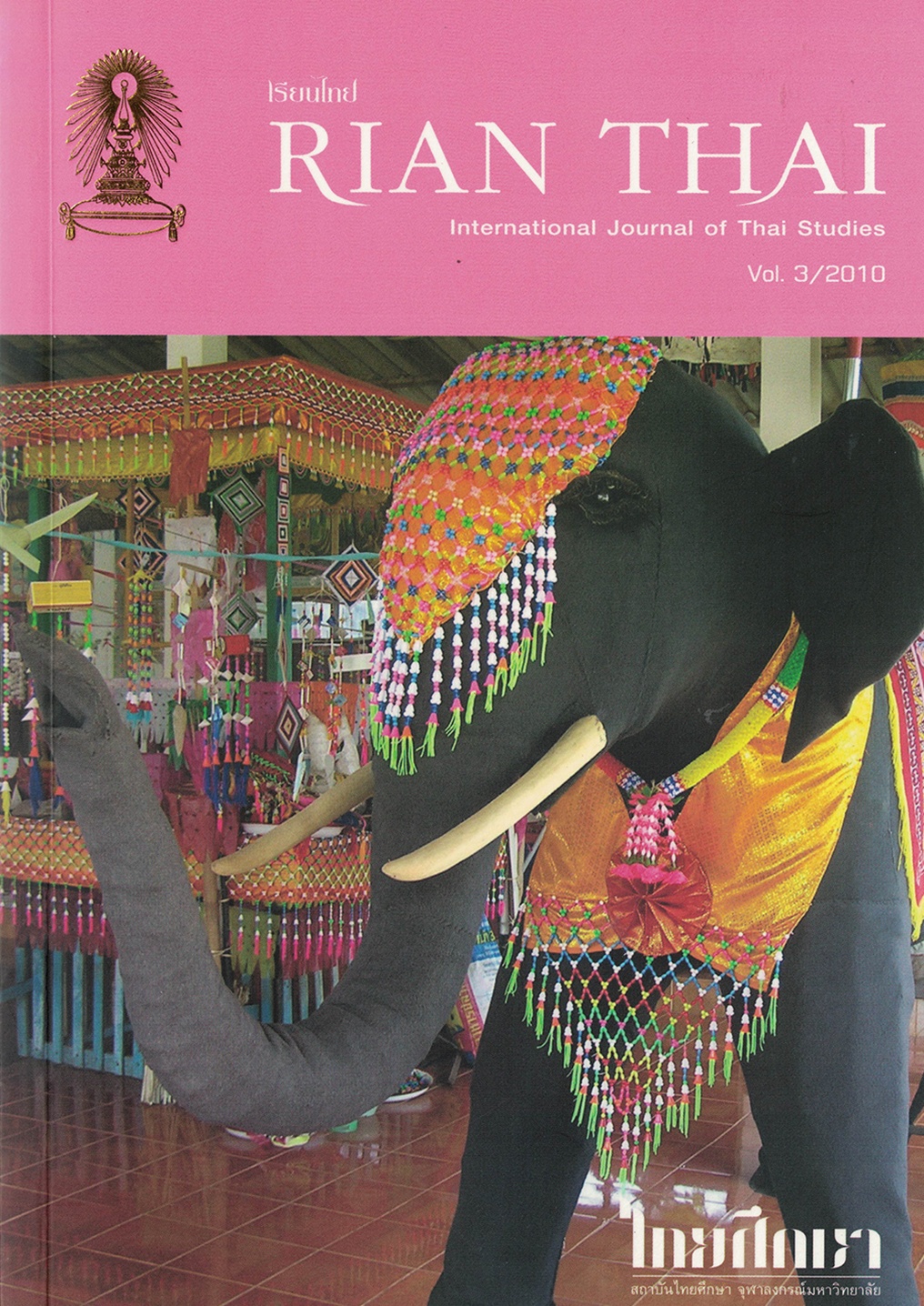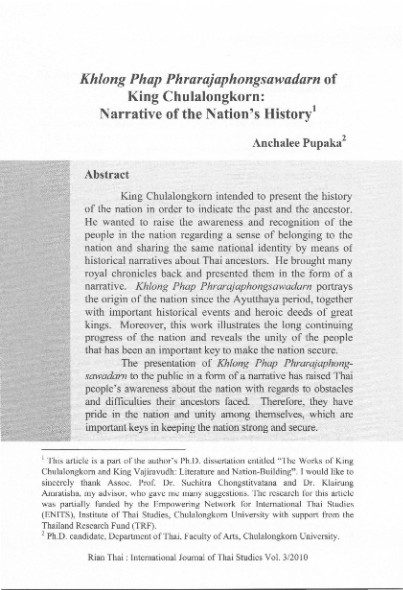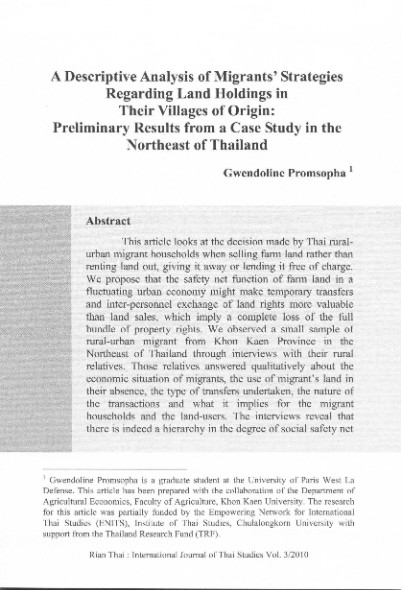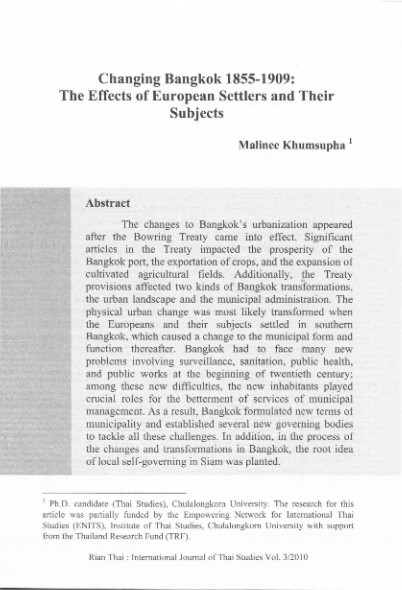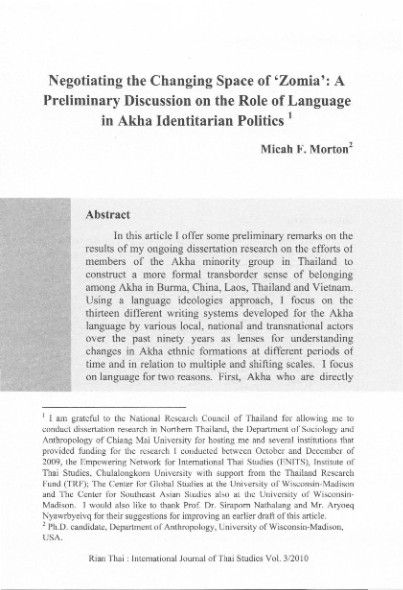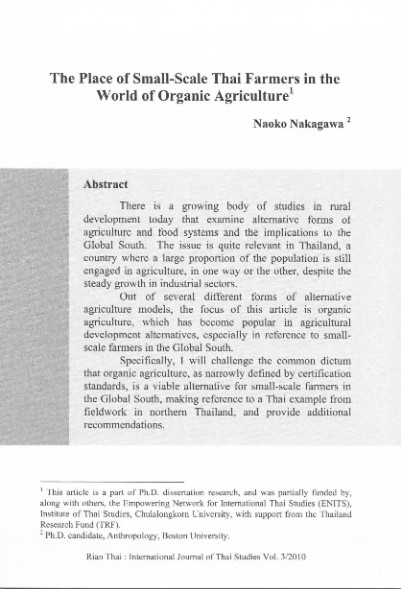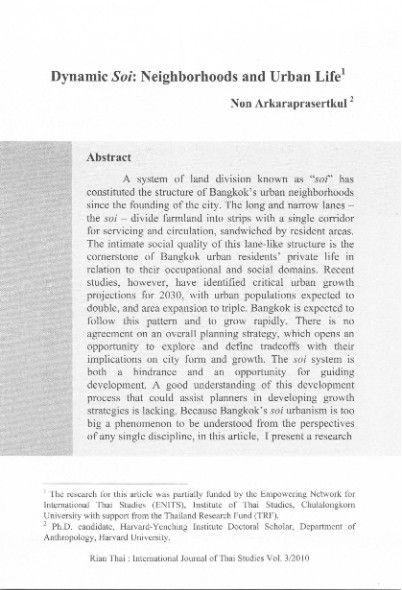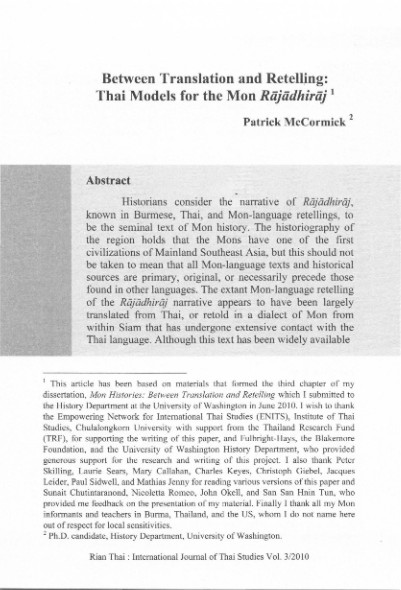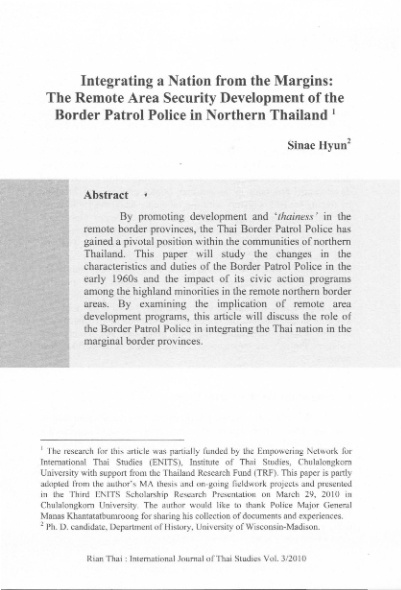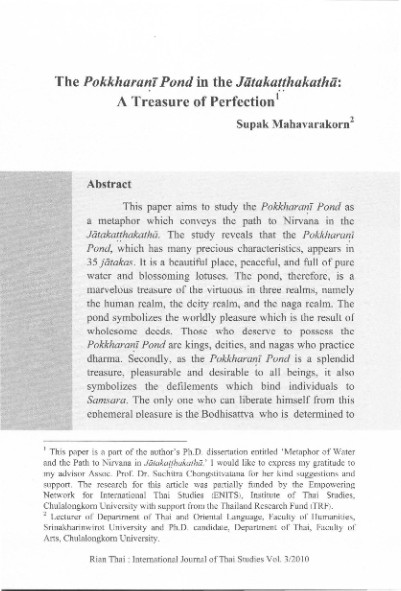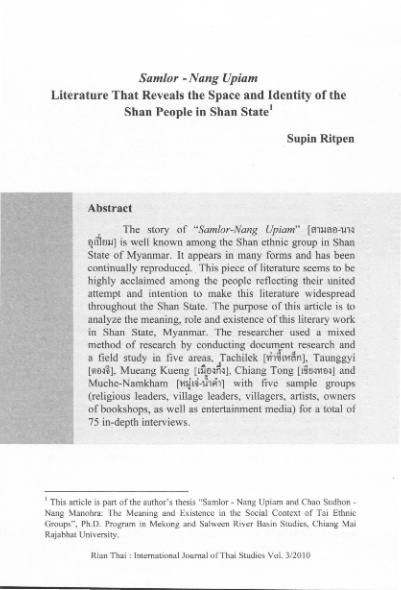Rian Thai - Volume 3/2010
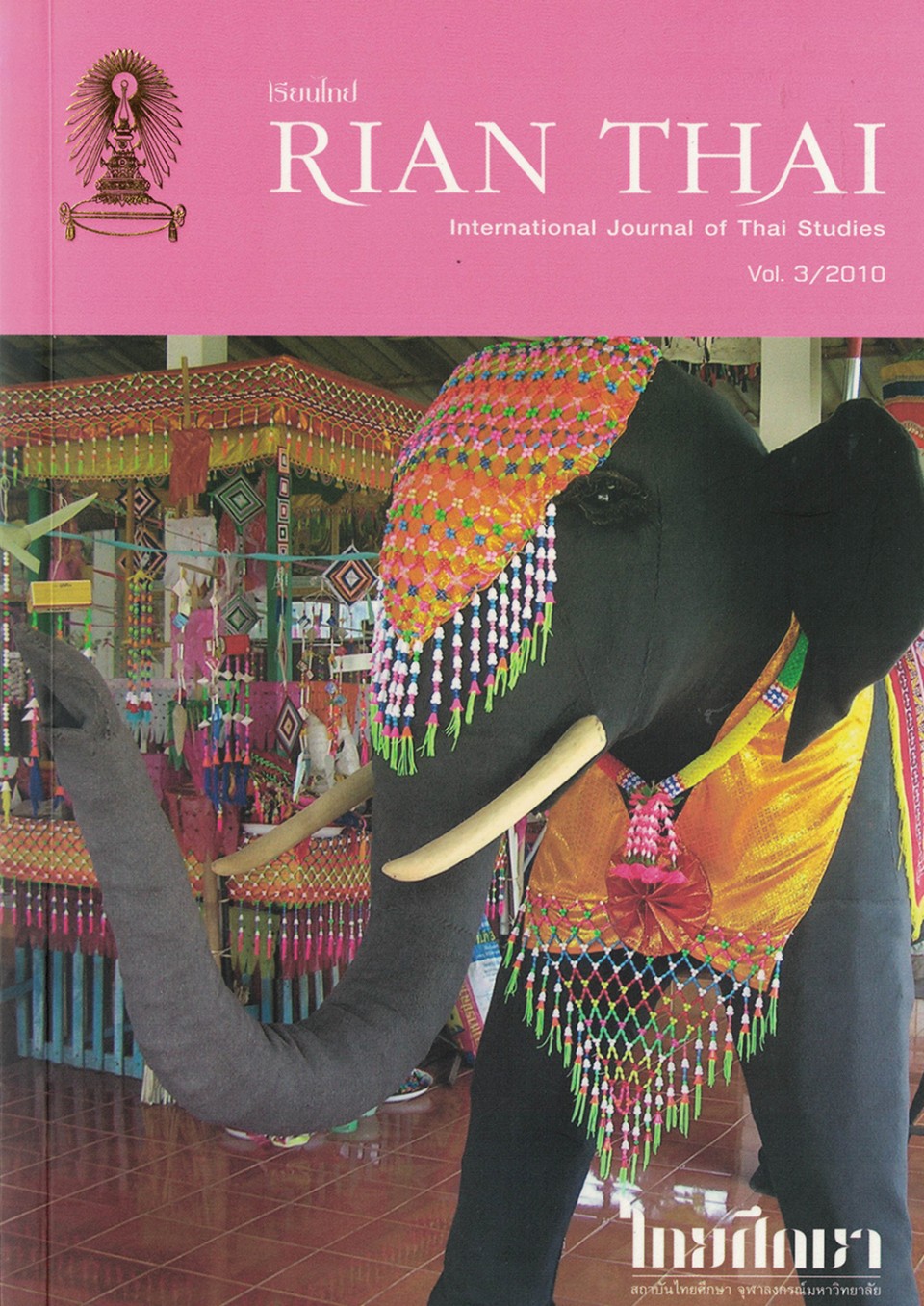
1) Khlong Phap Phrarajaphongsawadarn in King Chulalongkorn : Narrative of the Nation’s History / Anchalee Pupaka
2) A Descriptive Analysis of Migrants’ Strategies Regarding Land Holdings in Their Village of Origin : Preliminary Results from a Case Study in the Northeast of Thailand / Gwendoline Promsopha
3) Changing Bangkok 1855-1909 : The Effects of European Settlers and Their Subjects / Malinee Khumsupha
4) Negotiating the Changing Zomia of Mainland Southeast Asia : The Politics of Akha Identity / Micah Francis Morton
5) The Place of Small-Scale Farmers in the World of Organic Agriculture / Naoko Nakagawa
6) Dynamic Soi : Neighborhoods and Urban Life / Non Arkaraprasertkul
7) Thai Music Culture in 21st Century : Thai Music and Its Others (The Westernization and Globalization of Thai Classical Music) : Case Study of Thai Musical Instruments and Innovation / Paphutsorn Wongratanapitak
8) Between Translation and Retelling : Thai Models for the Mon Rajadhiraj / Patrick McCormick
9) Integrating the Nation from the Margins : The Remote Area Security Development of the Border Patrol Police in the Northern Thailand / Si Nae Hyun
10) Dvaravati Period Sema Stones : Shifting Meanings and Definitions in Archaeology, Epigraphy, Texts, and Religious Re-use / Stephen Anthony Murphy
11) The Pokkharani Pond in the Jatakatthakatha: A Treasure of Perfection / Supak Mahavarakorn
12) Samlor-Nang Upiam: Literature That Reveals the Space and Identity of the Shan People in Shan State / Supin Ritpen
Khlong Phap Phrarajaphongsawadarn in King Chulalongkorn : Narrative of the Nation’s History
Anchalee Pupaka
Abstract
King Chulalongkorn intended to present the history of the nation in order to indicate the past and the ancestor. He wanted to raise the awareness and recognition of the people in the nation regarding a sense of belonging to the nation and sharing the same national identity by means of historical narratives about Thai ancestors. He brought many royal chronicles back and presented them in the form of a narrative. Khlong Phap Phrarajaphongsawadarn portrays the origin of the nation since the Ayutthaya period, together with important historical events and heroic deeds of great kings. Moreover, this work illustrates the long continuing progress of the nation and reveals the unity of the people that has been an important key to make the nation secure.
The presentation of Khlong Phap Phrarajaphongsawadarn to the public in a form of a narrative has raised Thai people's awareness about the nation with regards to obstacles and difficulties their ancestors faced. Therefore, they have pride in the nation and unity among themselves, which are important keys in keeping the nation strong and secure.
(Published in Rian Thai: International Journal of Thai Studies, Volume 3/2010, Page 1-27)
Full Text : Download
A Descriptive Analysis of Migrants’ Strategies Regarding Land Holdings in Their Village of Origin : Preliminary Results from a Case Study in the Northeast of Thailand
Gwendoline Promsopha
Abstract
This article looks at the decision made by Thai rural-urban migrant households when selling farm land rather than renting land out, giving it away or lending it free of charge. We propose that the safety net function of farm land in a fluctuating urban economy might make temporary transfers and inter-personnel exchange of land rights more valuable than land sales, which imply a complete loss of the full bundle of property rights. We observed a small sample of rural-urban migrant from Khon Kaen Province in the Northeast of Thailand through interviews with their rural relatives. Those relatives answered qualitatively about the economic situation of migrants, the use of migrant's land in their absence, the type of transfers undertaken, the nature of the transactions and what it implies for the migrant households and the land-users. The interviews reveal that there is indeed a hierarchy in the degree of social safety net function that can be safeguarded through each type of transfers; land sales reduce considerably the access to the safety net directly or indirectly related to farm land, while land loans guarantee the best access to rural social protection. The safety net function of farm land for rural-urban migrants and how it affects the nature of farm land exchanges cannot be reduced to a simple analysis of asset property and needs to be taken into account within the wider complexity of the social network and rural ties in providing consumption smoothing mechanisms.
(Published in Rian Thai: International Journal of Thai Studies, Volume 3/2010, Page 29-63)
Full Text : Download
Changing Bangkok 1855-1909 : The Effects of European Settlers and Their Subjects
Malinee Khumsupha
Abstract
The changes to Bangkok's urbanization appeared after the Bowring Treaty came into effect. Significant articles in the Treaty impacted the prosperity of the Bangkok port, the exportation of crops, and the expansion of cultivated agricultural fields. Additionally, the Treaty provisions affected two kinds of Bangkok transformations, the urban landscape and the municipal administration. The physical urban change was most likely transformed when the Europeans and their subjects settled in southern Bangkok, which caused a change to the municipal form and fimction thereafter. Bangkok had to face many new problems involving surveillance, sanitation, public health, and public works at the beginning of twentieth century; among these new difficulties, the new inhabitants played crucial roles for the betterment of services of municipal management. As a result, Bangkok formulated new terms of municipality and established several new governing bodies to tackle all these challenges. In addition, in the process of the changes and transformations in Bangkok, the root idea of local self-governing in Siam was planted.
(Published in Rian Thai: International Journal of Thai Studies, Volume 3/2010, Page 65-96)
Full Text : Download
Negotiating the Changing Zomia of Mainland Southeast Asia : The Politics of Akha Identity
Micah Francis Morton
Abstract
In this article I offer some preliminary remarks on the results of my ongoing dissertation research on the efforts of members of the Akha minority group in Thailand to construct a more formal transborder sense of belonging among Akha in Burma, China, Laos, Thailand and Vietnam. Using a language ideologies approach, I focus on the thirteen different writing systems developed for the Akha language by various local, national and transnational actors over the past ninety years as lenses for understanding changes in Akha ethnic formations at different periods of time and in relation to multiple and shifting scales. I focus on language for two reasons. First, Akha who are directly involved in the transborder movement view the need for a unified writing system as fundamental in their project. Second, I hold that individual's beliefs and feelings about language and discourse, their language ideologies, are used to construct and represent particular social and cultural identities.
(Published in Rian Thai: International Journal of Thai Studies, Volume 3/2010, Page 97-133)
Full Text : Download
The Place of Small-Scale Farmers in the World of Organic Agriculture
Naoko Nakagawa
Abstract
There is a growing body of studies in rural development today that examine alternative forms of agriculture and food systems and the implications to the Global South. The issue is quite relevant in Thailand, a country where a large proportion of the population is still engaged in agriculture, in one way or the other, despite the steady growth in industrial sectors.
Out of several different forms of alternative agriculture models, the focus of this article is organic agriculture, which has become popular in agricultural development alternatives, especially in reference to smallscale farmers in the Global South.
Specifically, I will challenge the common dictum that organic agriculture, as narrowly defmed by certification standards, is a viable alternative for small-scale farmers in the Global South, making reference to a Thai example from fieldwork in northern Thailand, and provide additional recommendations.
(Published in Rian Thai: International Journal of Thai Studies, Volume 3/2010, Page 135-154)
Full Text : Download
Dynamic Soi : Neighborhoods and Urban Life
Non Arkaraprasertkul
Abstract
A system of land division known as "soi" has constituted the structure of Bangkok's urban neighborhoods since the founding of the city. The long and narrow lanes – the soi – divide farmland into strips with a single corridor for servicing and circulation, sandwiched by resident areas. The intimate social quality of this lane-like structure is the cornerstone of Bangkok urban residents' private life in relation to their occupational and social domains. Recent studies, however, have identified critical urban growth projections for 2030, with urban populations expected to double, and area expansion to triple. Bangkok is expected to follow this pattern and to grow rapidly. There is no agreement on an overall planning strategy, which opens an opportunity to explore and define tradeoffs with their implications on city form and growth. The soi system is both a hindrance and an opportunity for guiding development. A good understanding of this development process that could assist planners in developing growth strategies is lacking. Because Bangkok's soi urbanism is too big a phenomenon to be understood from the perspectives of any single discipline, in this article, I present a research project that is trans-disciplinary, cross-cultural, and historical in design. This research draws from the data and methods of history, geography, and political science to analyze key urban issues. This project seeks to understand in what ways the soi neighborhoods are the resilient element of Bangkok's urban culture that many claim them to be. Only firsthand experience in the soi communities can answer such questions and shed light on this unlikely phenomenon, with ramifications for developing urban spaces and aging metropolises alike.
(Published in Rian Thai: International Journal of Thai Studies, Volume 3/2010, Page 155-184)
Full Text : Download
Thai Music Culture in 21st Century : Thai Music and Its Others (The Westernization and Globalization of Thai Classical Music) : Case Study of Thai Musical Instruments and Innovation
Paphutsorn Wongratanapitak
Abstract
"Thai Music and Its Others" was inspired by Georgina Born and David Hesmondalgh from their publication "Western Music and Its Others" in 2002. This research topic implies the fact that Thai music has also been greatly influenced by other cultures, especially Western culture. This article provides a history and development of Thai music from the 1930s until the present in different areas, for example, musical instruments and innovations, composition, performance, media, transmission and music education, beliefs, and the connections of Thai classical music to the globe.
(Published in Rian Thai: International Journal of Thai Studies, Volume 3/2010, Page 185-206)
Full Text : Download
Between Translation and Retelling : Thai Models for the Mon Rajadhiraj
Patrick McCormick
Abstract
Historians consider the narrative of Rajadhiraj, known in Burmese, Thai, and Man-language retellings, to be the seminal text of Mon history. The historiography of the region holds that the Mons have one of the first civilizations of Mainland Southeast Asia, but this should not be taken to mean that all Moo-language texts and historical sources are primary, original, or necessarily precede those found in other languages. The extant Man-language retelling of the Rajadhiraj narrative appears to have been largely translated from Thai, or retold in a dialect of Mon from within Siam that has undergone extensive contact with the Thai language. Although this text has been widely available in print for a hundred years, no scholars have commented on the unusual features of the language that the text is recorded in. Indeed, because of the assumption of Mon primacy, many scholars may not be able to conceive of the narrative as having come from outside Mon-language sources.
As part of a larger project of examining interpretative communities and frameworks, this article explores a specific example of how linguistic evidence may challenge the usual understandings and interpretations of Mainland Southeast Asian histories. A linguistic analysis of the text from the perspective of the scholarship on language contact and convergence reveals how native Mon words, phrases, and grammatical constructions have been reinterpreted to replicate Thai models. To gauge the language of this text, consider examples from contemporaneous texts produced inside Burma. Rather than searching for the original "version" or language of the narrative, I consider linguistic evidence to rethink how historical narratives may have been passed down to the present. The evidence suggests a heterogeneity of predecessors and modes of transmission.
(Published in Rian Thai: International Journal of Thai Studies, Volume 3/2010, Page 207-232)
Full Text : Download
Integrating the Nation from the Margins : The Remote Area Security Development of the Border Patrol Police in the Northern Thailand
Si Nae Hyun
Abstract
By promoting development and 'thainess' in the remote border provinces, the Thai Border Patrol Police has gained a pivotal position within the communities of northern Thailand. This paper will study the changes in the characteristics and duties of the Border Patrol Police in the early 1960s and the impact of its civic action programs among the highland minorities in the remote northern border areas. By examining the implication of remote area development programs, this article will discuss the role of the Border Patrol Police in integrating the Thai nation in the marginal border provinces.
(Published in Rian Thai: International Journal of Thai Studies, Volume 3/2010, Page 233-258)
Full Text : Download
Dvaravati Period Sema Stones : Shifting Meanings and Definitions in Archaeology, Epigraphy, Texts, and Religious Re-use
Stephen Anthony Murphy
Abstract
Sema stones, or Buddhist boundary markers as they are commonly known in English, are a well attested phenomenon in the religious landscape of Southeast Asia. In modern day Theravada Buddhism they demarcate the sacred precinct of the ubosot, either in groups of eight or sixteen. The earliest archaeological evidence for these objects dates back to the Dvaravati Period (6th-11th century CE) where they are found at numerous sites and settlements throughout northeast Thailand and central and southern Laos, an area geographically defined as the Khorat Plateau. In scholarship to date, however, explanations regarding the function of Dvaravati sema have largely relied on modem analogies and comparisons and textual sources. Therefore, is it presumed that sema in the Dvaravati period functioned more or less in the same way as they do today, being set up in groups of eight or sixteen to demarcate the ubosot alone. Archaeological and epigraphic evidence, however, paints a somewhat different picture, illustrating that in some cases sema were placed around stupas, Buddha images and rock shelters, and that the numbers used could vary between eight and twenty-four. The epigraphic evidence further illustrates that sema fulfilled important social functions as objects of patronage and merit donated by local elites. Additionally, sema's re-use today in Buddhist contexts illustrates their continual sacred appeal and alternative functions. This article re-evaluates the function, use and definition of Dvaravati sema by drawing on archaeological, textual, epigraphic, typological and contemporary evidence. Finally this article acts as a cautionary tale, highlighting the pitfalls and problems inherent in projecting modem religious beliefs and practice onto the past.
(Published in Rian Thai: International Journal of Thai Studies, Volume 3/2010, Page 259-282)
Full Text : Download
The Pokkharani Pond in the Jatakatthakatha : A Treasure of Perfection
Supak Mahavarakorn
Abstract
This paper aims to study the Pokkharani Pond as a metaphor which conveys the path to Nirvana in the Jatakatthakatha. The study reveals that the Pokkharani Pond, which has many precious characteristics, appears in 35 jatakas. It is a beautiful place, peaceful, and full of pure water and blossoming lotuses. The pond, therefore, is a marvelous treasure of the virtuous in three realms, namely the human realm, the deity realm, and the naga realm. The pond symbolizes the worldly pleasure which is the result of wholesome deeds. Those who deserve to possess the Pokkharani Pond are kings, deities, and nagas who practice dharma. Secondly, as the Pokkharani Pond is a splendid treasure, pleasurable and desirable to all beings, it also symbolizes the defilements which bind individuals to Samsara. The only one who can liberate himself from this ephemeral pleasure is the Bodhisattva who is determined to renounce Samsara and becomes a Buddha. In many jatakas, the Bodhisattva resides at the Pokkharani Pond where he practices contemplation.
In this context, the pond, which is peaceful, full of pure water and blossoming lotuses, symbolizes the serenity, wisdom and the fulfillment of perfection of the Bodhisattva. As a result, we may see clearly that the Pokkharani Pond, as a metaphor of water, is a literary technique significantly
used in the Jatakatthakatha to connote the process of dharma practice or, in other words, the path to Nirvana.
(Published in Rian Thai: International Journal of Thai Studies, Volume 3/2010, Page 283-301)
Full Text : Download
Samlor-Nang Upiam : Literature That Reveals the Space and Identity of the Shan People in Shan State
Supin Ritpen
Abstract
The story of "Samlor-Nang Upiam" [สามลอ-นางอุเปี่ยม] is well known among the Shan ethnic group in Shan State of Myanmar. It appears in many forms and has been continually reproduce~. This piece of literature seems to be highly acclaimed among the people reflecting their united attempt and intention to make this literature widespread throughout the Shan State. The purpose of this article is to analyze the meaning, role and existence of this literary work in Shan State, Myanmar. The researcher used a mixed method of research by conducting docum,ent research and a field study in five areas, Tachilek [ท่าขี้เหล็ก], Taunggyi [ตองจี], Mueang Kueng [เมืองกึ๋ง], Chiang Tong [เชียงทอง] and Muche-Narnkham [หมู่เจ่-น้ำคำ] with five sample groups (religious leaders, village leaders, villagers, artists, owners of bookshops, as well as entertainment media) for a total of 75 in-depth interviews.
Data was collected through observation and interviews as well. The analysis was based on theories of folklore, sociology and anthropology in order to investigate the meaning of existence in the social context of this literary work. The result showed that besides its value and role as an aesthetic media, stimulating the people's consciousness in terms of ethnic, sacred space and cultural tourism, this literary work, Sam/or-Nang Upiam, also serves as a tool for social discourse that is reproduced and passed on by the Shan leaders comprising monks, artists and leaders of the Shan State Army, to define their identity or existence and space during rule of the Burmese Military Government.
(Published in Rian Thai: International Journal of Thai Studies, Volume 3/2010, Page 303-324)
Full Text : Download
